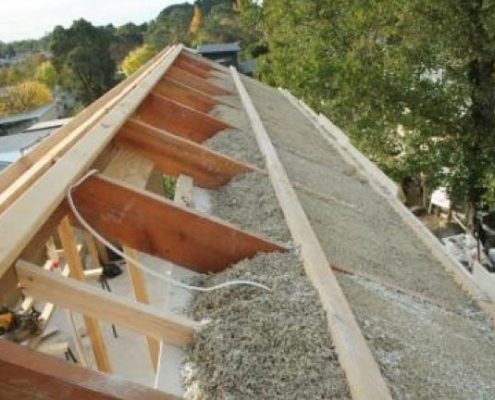Thermal Performance
| Thickness | 100mm | 150mm | 200mm | 250mm | 300mm | 400mm |
|---|---|---|---|---|---|---|
| Roofing Insulation | RT2.0 | RT3.0 | RT4.0 | RT5.0 | RT6.0 | RT8.0 |
| Walls | RT1.4 | RT2.1 | RT2.85 | RT3.55 | RT4.25 | RT5.0 |
| Subfloor Insulation | RT2.0 | RT3.0 | RT4.0 | RT5.0 | RT6.0 | RT8.0 |
Research indicates energy savings of between 50 – 80% on heating and cooling in hemp buildings.
Benefits of a Hemp Home
- High thermal insulation
- 50% – 80% energy savings
- FIRE PROOF
- Termite resistant
- Breathable walls
- Design flexibility
- Prevents mould
- CO2 sequestration
- Negative carbon footprint
- Healthy living environment
- Inherently Airtight
- High acoustic performance
- No waste
- No Dry Rot
- Low Air Infiltration
- ZERO LAND FILL
Facts
Buildings made of hemp:
- store the carbon from a renewable biomass throughout the life of the building material
- create a vapour-permeable construction envelope that ensures healthy indoor air quality
- provide excellent thermal insulation and some thermal mass
- avoid thermal bridging and provides good airtightness with simple detailing and
- are simple to construct. Hemp building requires care but the skills are easy to learn.
- reduce the load on foundations because it is light weight material,it
- can have zero waste, as previously mixed material can be reintroduced in controlled proportions to new mixes.
- For optimal durability once dried, exterior hemp walls should be finished with a Hemp lime, Lime or other natural render or breathable finish. Other than this hemp lime needs no unusual protection from the elements.
Advantages
Hemp-lime has a low impact on the environment and its carbon sequestration and storage capacity are a significant benefit of the material. During photosynthesis, the hemp plant absorbs carbon dioxide from the atmosphere during the day, converting carbon to biomass and exhaling oxygen. When the hemp is subsequently used in construction, the carbon within it is locked away for the life of the building. Therefore, using hemp within the structure of a building can be better than zero carbon, sometimes referred to as carbon negative. 108kg of CO2 can be locked away in 1m3 of lime-hemp.
A lime-hemp wall of 200mm depth provides levels of thermal and acoustic insulation well above regulation standard. It also regulates the internal relative humidity and temperature swings ‘through hygroscopic material behaviour, contributing to healthier building spaces and providing effective thermal mass’.The building envelope is vapour permeable which allows moisture in the building to migrate out and eliminates the likelihood of condensation on internal faces.
Simplification of the construction process with fewer materials and layers is also a benefit. It is usually where different layers or materials meet that failure occurs and it is also more cost effective to have one material performing many functions rather than many materials each performing a single role. For example, in a standard timber frame construction you may expect to find a layer of insulation, a vapour barrier layer, a breather membrane layer and a sheathing layer to name but a few. However hemp-lime itself can perform all of these functions and, due to the reduction of connections, a more air tight envelope can be achieved.
Unlike concrete, lime’s mechanical flexibility allows movement without cracking. If a crack does appear the lime acts in a manner which can self heal. Any moisture ingress re-activates the lime around the crack, filling the void and sealing the material. This flexibility also allows movement with the frame, reducing the risk of gaps appearing between hemp-lime and structure.
About Hemp
Kevin McLeod’s explanation on Hempcrete
Building The Future With Hempcrete Homes – Western Australia’s Latest Locally Grown Home!
Building A Sustainable Industry
Heartbeat Of The Industry – Hemp Processing in Margaret River
Consider This
Hemp
Industrial hemp is a different strain of Cannabis Sativa containing very little of the psychoactive substance found in marijuana. You simply cannot get high on industrial hemp. See this blog for more explanation.
Hemp is a genetically diverse species, with varieties adapted to a wide range of latitudes and climatic zones. It is a summer annual, short-day flowering plant, with 2-3 crops per year in some areas of Australia. The fibre of the hemp plant comes from the stalk, which is comprised of bast (the outer bark fraction of the stem) and the hurd (which is the inner woody core). Hemp as a fibre crop grows over the peak of summer, typically a 100-120 day crop harvested in January and February. It is a low cost crop, with minimal infield operations post planting. A grower requires an appropriate state licence or permit to grow industrial hemp. (HEMPCO.)
Hemp is far more productive than typical agro-forestry projects, producing annual, versatile biomass alongside more rapid CO2 uptake. It can produce a vast range of sustainable raw materials with an overall low environmental impact, as well as improving soil structure, using low fertiliser and no other chemical inputs (i.e. reduced agrochemical residues).
Hemp can be grown on existing agricultural land (unlike most forestry projects), and can be included as part of a farm’s crop rotation with positive effects on overall yields of follow on crops. This, along with super versatility in diverse soil conditions and climates, makes hemp cultivation a viable and genuine potential large scale contributor to GHG mitigation. (www.hempglobalsolutions.com/science2.php)
It is estimated that hemp cropping will sequester an average of 10 tonnes of carbon dioxide per hectare. (www.hempglobalsolutions.com/science2.php
The mixture of hemp shiv and a lime-based binder with the addition of water produces a bio-composite material often called hemp-lime . As with the early use of hemp within concrete, in hemp-lime the shiv performs as a lightweight aggregate and the lime as binder and preservative. This composite material is rigid, lightweight and durable, while achieving high levels of thermal insulation and vapour permeability.
Lime’s unique chemical and physical properties are ideal for its combination with hemp. Throughout the lime’s curing process it retains a high permeability which allows vapour to migrate through the composite, therefore allowing the hemp chips to dry out completely. This coupled with the lime’s alkalinity, acting as a natural biocide, ensures the hemp shiv is safe from mould and bacterial attack.
Lime
Lime manufacture involves high temperature kiln operations to break down the limestone. Kiln temperatures will range from 900-1000oC depending on the composition of the limestone. Portland Cement, the basis of most concrete, is also made from burning limestone but requires higher energy outputs with kilns needing to reach temperatures of 1450oC and higher.
Find further information on the difference of lime and cement renders or the mineralogy of binders and the Effects of Free Lime content and Cement addition in Lime Mortars here.
The lime binder cycle for hempcrete is shown in the flowchart below:

NB: CaCo3 (limestone) goes the full circle from being broken down to carbonation when hempcrete is formed. As the hempcrete hardens from carbonation, it will eventually petrify the hemp and form limestone.
Hempcrete
Hempcrete is environmentally sustainable:
a) Carbon Sequestration
It is a carbon-sequestering building material from the growth of hemp to the carbonation of lime in the walls for the life of the building.
The breakdown of the carbon sequestration is as follows:
- In 1 cubic metre mix of hempcrete, emitted CO2 is:
- 110kg of hemp hurd = – 202 kg (CO2 absorbed)
- 220 kg of lime binder = +94 kg (CO2 released)
- Total sequestration = -108 kg/m3 of wall built
b) Energy Conservation
It reduces energy consumption because of its excellent insulation and airtightness. There is little heating or cooling losses from the building which means constant energy output to keep the building cool or warm is not required. Because hempcrete has low effusivity and high thermal inertia, it does not take as long to heat a house but once heated, it will slowly release heat back in when the temperature drops … so the heater doesn’t need to stay on all night.
c) Recyclable
Hempcrete is fully recyclable. Any waste on site can be re-used in the next mix. If the building is being demolished, the hempcrete can be easily broken down and used in a new build. As landfill, hempcrete, being a natural product, will break down over the course of time, add lime and organic matter to the soil.
Hempcrete has no equal for its environmental and energy saving credentials in building materials.

